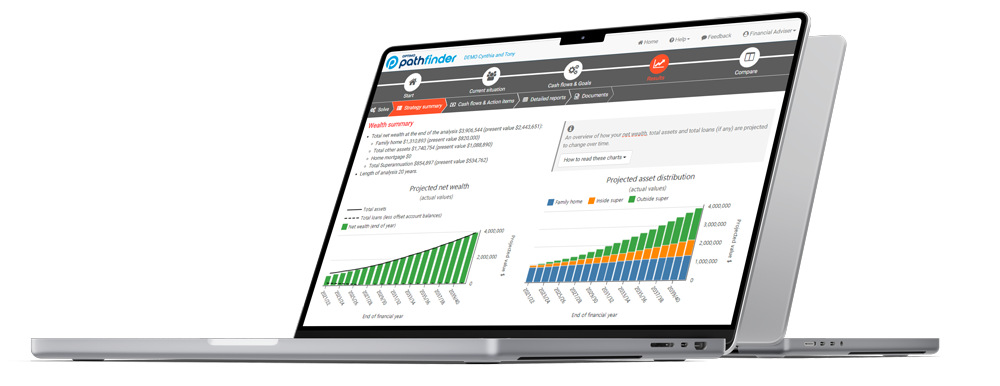Property strategies for Tom and Rita
Introduction
This case study showcases modelling property-related strategies in Pathfinder, and introduces our latest feature of making exact borrowings on loans (instead of strictly optimising). Select this sample case data at the ‘Start’ step of your case to see how each scenario is modelled!
Tom and Rita Demo, a high earning married couple in their early forties, have been saving up for a deposit for their second investment property. They are seeking advice on a long term strategy for building wealth with property, having expressed interest in buying in Bega and Canberra.
After discussing their situation and goals, their advisor prepares 4 scenarios in Pathfinder to compare alternative courses of action, based on the following assumptions.
Assumptions
Analysis starts 1 July 2023, ends 1 July 2043 (20 years)
| Item | Assumed rates |
| AWOTE | 4% from 2022/23; then 3.5% from 2025/26 |
| CPI | 3% from 2023/24; then 2.5% from 2025/26 |
|
Cash account return |
4.1% from 2023/24; then 3.2% from 2025/26 |
|
Growth fund (inside super) |
|
|
Investment property |
|
| Family home |
|
| Interest rate | All secured principal and interest loans 6%pa. |
Scenarios
Scenario | Description |
Basic cash flows | The couple make no new investments or voluntary contributions to super. They only make minimum repayments towards their loans, and save all excess funds in their bank account. |
Build property portfolio – Optimised borrowings | The couple purchase 2 new investment properties:
Borrowings and repayments are optimised by Pathfinder. Equity from the Family home is only used for a loan for Bega’s deposit. |
Build property portfolio – Exact borrowings | Instead of optimising borrowings, the couple take on less debt to purchase the 2 new investment properties. This could be for emotional or practical reasons, such as the couple worrying about debt levels, or the bank not offering to lend the ‘optimal’ amount. |
Build property portfolio – with Debt Recycling | The couple prioritise paying down the Family home mortgage with income from their investment property. They use available Family home equity to take out loans for Bega and Canberra. |
Results
Figure 1: Comparison of projected final net wealth across scenarios

Figure 2: Comparison of projected total tax across scenarios
Scenario | Final Net Wealth | Analysis |
Basic cash flows | $10,578,584 | This baseline scenario allows you to identify the surplus cash, if the couple ‘do nothing’. Each year, the couple have excess cash ranging from $106,000 to $190,000; and by the end-of-analysis, their cash balance is projected to be $1,758,303. This money can be used in alternative scenarios, such as making extra mortgage repayments, or as deposits for new property investments. |
New property – Optimised borrowings | $11,083,300 | This strategy utilises Pathfinder’s optimisation in determining borrowings and repayments for their existing and new properties. Borrowings for new properties:
All loans are feasible: Home loan is repaid in 5 years, and other loans are repaid before the end of analysis. |
New property – Exact borrowings | $11,077,256 | This builds on the prior scenario, but considers a more practical strategy instead of something strictly mathematically optimal – so the projected net wealth at the end of analysis is slightly lower than the previous scenario. Borrowings for new properties:
|
New property – Debt Recycling | $11,101,414 | This more complex strategy boosts the couple’s end of analysis net wealth by about $18,000 to $24,000, compared to the previous 2 scenarios. As well, by focusing repayments towards the Family home loan, it is paid off a year earlier, reducing non-tax-deductible interest – leading to tax savings of $5,400 to $8,500 over 20 years. Borrowings for new properties:
The couple will need to consider whether this marginal benefit is worth the additional effort in implementing the strategy. |
Conclusion
Based on the assumptions, scenarios leading to greater net wealth require more effort or risk, which will need to be considered. Together with the advisor, the couple may decide that, out of the presented scenarios, the ‘New property – Optimised borrowings’ is best for them, because:
- They would like to invest, instead of saving cash
- They are okay with taking on high debt, and are able to obtain any required loans from the bank
- The marginal benefit of the Debt recycling strategy is not worth the extra effort
Note that the above results depend on the assumptions of this case: Scenarios were kept simple, and no voluntary super contributions are made. However, you can further explore this sample case, and see how including super contributions, other investments, or cash flows may alter the results.
Get in touch!
- Book a demo
- Start a free trial
- Contact us on support@optimofinancial.com.au or 1300 678 460

